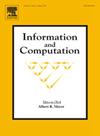k-Universality of Regular Languages
IF 1
4区 计算机科学
Q3 COMPUTER SCIENCE, THEORY & METHODS
引用次数: 0
Abstract
A subsequence of a word w is a word u such that , for some set of indices . A word w is k-subsequence universal over an alphabet Σ if every word in appears in w as a subsequence. In this paper, we study the intersection between the set of k-subsequence universal words over some alphabet Σ and regular languages over Σ. We call a regular language L k-∃-subsequence universal if there exists a k-subsequence universal word in L, and k-∀-subsequence universal if every word of L is k-subsequence universal. We give algorithms solving the problems of deciding if a given regular language, represented by a finite automaton recognising it, is k-∃-subsequence universal and, respectively, if it is k-∀-subsequence universal, for a given k. The algorithms are FPT w.r.t. the size of the input alphabet, and their run-time does not depend on k; they run in polynomial time in the number n of states of the input automaton when the size of the input alphabet is . Moreover, we show that the problem of deciding if a given regular language is k-∃-subsequence universal is NP-complete, when the language is over a large alphabet. Further, we provide algorithms for counting the number of k-subsequence universal words (paths) accepted by a given deterministic (respectively, non-deterministic) finite automaton, and ranking an input word (path) within the set of k-subsequence universal words accepted by a given finite automaton.
k-规则语言的普遍性
单词w的子序列是一个单词u,使得u=w[i1]w[i2]…w[ik],对于某些索引集1≤i1<;i2<;…<ik≤|w|。如果Σk中的每个单词都作为子序列出现在w中,那么单词w就是整个字母表Σ上的k-子序列。在本文中,我们研究了一些字母表Σ上的k-子序列全称词集与Σ上的规则语言集之间的交集。如果在L中存在一个k-子序列全称词,我们称正则语言为k-∃-子序列全称词;如果L的每个词都是k-子序列全称词,我们称正则语言为k-∃-子序列全称词。我们给出了一些算法来解决以下问题:对于给定的k,决定一个给定的正则语言(由一个有限自动机识别它)是否为k-∃-子序列全域,以及是否为k-∀-子序列全域。这些算法是FPT .r.t.输入字母的大小,它们的运行时间不依赖于k;当输入字母的大小为O(log log n)时,它们在输入自动机的n个状态下以多项式时间运行。此外,我们证明了判定给定正则语言是否为k-∃-子序列全称的问题是np完全的,当该语言在一个大字母表上时。此外,我们提供了计算给定确定性(分别是非确定性)有限自动机接受的k-子序列通用词(路径)数量的算法,并在给定有限自动机接受的k-子序列通用词集合中对输入词(路径)进行排序。
本文章由计算机程序翻译,如有差异,请以英文原文为准。
求助全文
约1分钟内获得全文
求助全文
来源期刊

Information and Computation
工程技术-计算机:理论方法
CiteScore
2.30
自引率
0.00%
发文量
119
审稿时长
140 days
期刊介绍:
Information and Computation welcomes original papers in all areas of theoretical computer science and computational applications of information theory. Survey articles of exceptional quality will also be considered. Particularly welcome are papers contributing new results in active theoretical areas such as
-Biological computation and computational biology-
Computational complexity-
Computer theorem-proving-
Concurrency and distributed process theory-
Cryptographic theory-
Data base theory-
Decision problems in logic-
Design and analysis of algorithms-
Discrete optimization and mathematical programming-
Inductive inference and learning theory-
Logic & constraint programming-
Program verification & model checking-
Probabilistic & Quantum computation-
Semantics of programming languages-
Symbolic computation, lambda calculus, and rewriting systems-
Types and typechecking
 求助内容:
求助内容: 应助结果提醒方式:
应助结果提醒方式:


